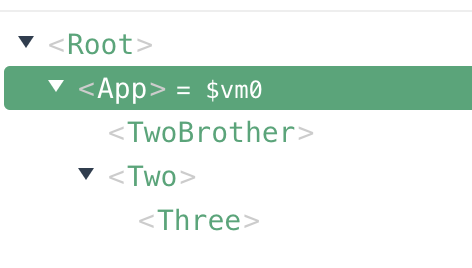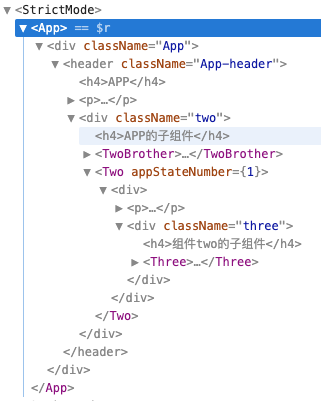vue和react都使用了虚拟DOM,其中一个优点就是通过diff算法只更新部分组件,提升了DOM重绘性能。网上有些人说vue只更新变化的组件,而react更新所有组件,这样的话react的diff算法是摆设吗,实际情况是怎样的?下面我们来一探究竟。
Vue组件更新
下面来测试一下Vue组件data更新会影响哪些组件。定义了三层组件,APP > [Two、TwoBrother] > Three, 最下图:

组件Two的代码如下:
<template>
<div>
<p>组件Two two_number = [{{two_number}}] <button @click="twoNumberAdd">two_number + 1</button></p>
<div class="three">
<Three />
</div>
</div>
</template>
<script>
import Three from './Three.vue'
export default {
name: 'Two',
components: {
Three
},
data() {
return {
two_number: 1
}
},
methods: {
twoNumberAdd() {
this.two_number += 1;
}
},
updated() {
console.log('component two update');
}
}
</script>
当更新组件two two_number时,打印结果如下:

当更新组件app app_number时,打印结果如下:

再测试一下更新父组件传给给子组件的props时的情况:
<Two :user-name="userName"/> <button @click="modifyProps">更改传递给子组件的props</button> modifyProps() { this.userName = 'gao'; },
当更新userName时子组件情况如下:

可见父子组件都更新了。
vue总结:
1.当更新父组件data中的数据时,其自身组件更新,其子组件(无限递归)不会更新
2.更新某个组件data中的数据时,其兄弟组件不更新
3.当更新子组件data中的数据时,父组件不更新
4.当更新父组件传递给子组件的props变化时,子组件(第一级子组件)更新。
注:这些测试都是数据在html中被使用的前提下,如果数据在html中未使用,update不会更新。
React组件更新
下面来测试一下React组件state更新会影响哪些组件。定义了三层组件,APP > [Two、TwoBrother] > Three, 最下图:

组件Two代码如下:
class Two extends React.Component { state = { two_number: 1 } twoNumberAdd = () => { this.setState({ two_number: this.state.two_number + 1 }); } componentDidUpdate() { console.log('compoent two update'); } render() { return ( <div> <p> 组件Two。two_number = [{this.state.two_number}] <button onClick={this.twoNumberAdd}>two_state_number + 1</button> </p> <div className="three"> <h4>组件two的子组件</h4> <Three></Three> </div> </div> ) } }
当更新组件Two的state two_number时,打印结果如下:

当更新APP的state app_number时,打印结果如下:

react总结:
1.当更新父组件state中的数据时,其自身组件及所有子组件(无限递归)都会更新
2.更新某个组件,其兄弟组件不更新
3.当更新子组件,父组件不更新
总结
通过vue和react组件更新对比,可以看出他们的区别:
vue组件data更新只更新自己,react组件state更新会更新自己及所以有子组件。
测试代码详见:https://github.com/dxdleikai/vueCompoenentUpdate https://github.com/dxdleikai/reactComponentUpdate